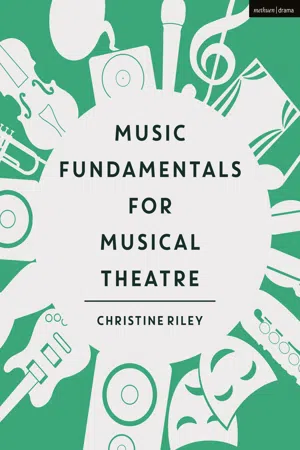
Music Fundamentals for Musical Theatre
Christine Riley
- 296 pages
- English
- ePUB (adapté aux mobiles)
- Disponible sur iOS et Android
Music Fundamentals for Musical Theatre
Christine Riley
À propos de ce livre
Musical theatre students and performers are frequently asked to learn musical material in a short space of time; sight-read pieces in auditions; collaborate with accompanists; and communicate musically with peers, directors, music directors and choreographers. Many of these students and performers will have had no formal musical training. This book offers a series of lessons in music fundamentals, including theory, sight-singing and aural tests, giving readers the necessary skills to navigate music and all that is demanded of them, without having had a formal music training. It focuses on the skills required of the musical theatre performer and draws on musical theatre repertoire in order to connect theory with practice. Throughout the book, each musical concept is laid out clearly and simply with helpful hints and reminders. The author takes the reader back to basics to ensure full understanding of each area. As the concepts begin to build on one another, the format and process is kept the same so that readers can see how different aspects interrelate. Through introducing theoretical ideas and putting each systematically into practice with sight-singing and ear-training, the students gain a much deeper and more integrated understanding of the material, and are able to retain it, using it in voice lessons, performance classes and their professional lives. The book is published alongside a companion website, which offers supporting material for the aural skills component and gives readers the opportunity to drill listening exercises individually and at their own pace. Music Fundamentals for Musical Theatre allows aspirational performers - and even those who aren't enrolled on a course - to access the key components of music training that will be essential to their careers.
Foire aux questions
Informations
1
The Staff, Treble Clef, Pitches on the Staff, Solfege, and Sight-Singing











Sight-Singing
Table des matières
- Cover
- Half Title
- Title Page
- Contents
- Introduction: Why Music Fundamentals for Musical Theatre Students?
- 1 The Staff, Treble Clef, Pitches on the Staff, Solfege, and Sight-Singing
- 2 Rhythm: Whole Notes, Half Notes, Quarter Notes, and Eighth Notes
- 3 The Piano Keyboard, Accidentals, Whole and Half Steps, Major Scales
- 4 The Circle of Fifths and Major Key Signatures
- Review of Chapters 1–4 and Performance Tips (Tempo)
- 5 Intervals: Seconds and Thirds and Phrase Shapes
- 6 Intervals: Fourths, Fifths, and Octaves; Rhythm: Sixteenth Notes
- 7 Intervals: Sixths and Sevenths; Rhythm: Rests
- 8 Diminished and Augmented Intervals; Rhythm: Syncopation
- Review of Chapters 5–8 and Performance Tips (Musical Markings)
- 9 Rhythm: Ties, Dotted Notes, 2/4 and 3/4 Time; Song Analysis
- 10 Major Triads; Introduction to Bass Clef and the Grand Staff
- 11 I, IV, V Progression; Chord Tones and Non-Chord Tones; Song Analysis
- 12 Transpositions; Rhythm: Triplets
- Review of Chapters 9–12 and Performance Tips (Repeats, Endings, and Codas)
- 13 Minor, Diminished, and Augmented Triads; Cut-Time; Chromatic Solfege
- 14 I, vi, ii, V, I Progression; Harmonizing a Melody
- 15 Inversions of Triads
- 16 Chord Progressions with Inversions
- Review of Chapters 13–16 and Performance Tips (The Music Department)
- 17 Dominant Seventh Chords; V of V Chords; Suspended Chords; Song Analysis
- 18 Minor Key Signatures and Natural Minor Scales
- 19 Harmonic Minor Scales and Melodic Minor Scales; Song Analysis
- 20 Minor Chord Progressions; Song Analysis
- Review of Chapters 17–20 and Performance Tips (Song Form)
- 21 Major, Minor, Half-Diminished, and Diminished Seventh Chords
- 22 Compound Time
- 23 More Compound Time; Song Analysis
- 24 Song Analysis; Orchestration
- Resources
- Permissions Acknowledgements
- Index
- Copyright